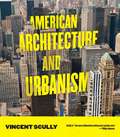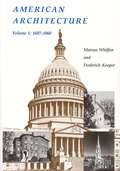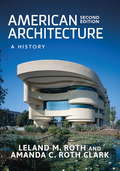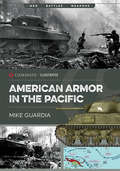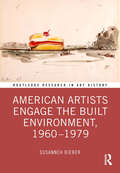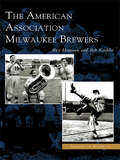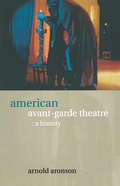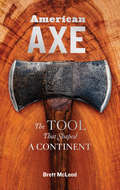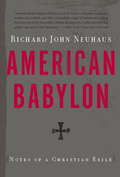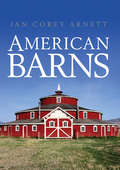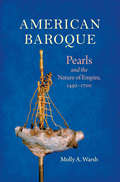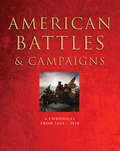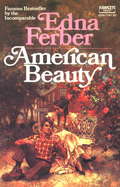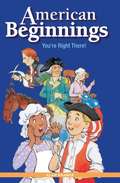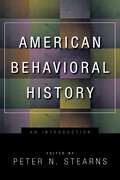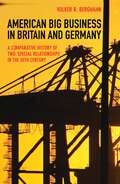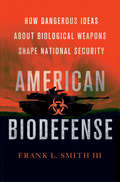- Table View
- List View
American Architectural History: A Contemporary Reader
by Keith Eggener<p>This major new text presents a collection of recent writings on architecture and urbanism in the United States, with topics ranging from colonial to contemporary times. In terms of content and scope, there is no collection, in or out of print, directly comparable to this one. The essays are drawn from the past twenty years' of publishing in the field, arranged chronologically from colonial to contemporary and accessible in thematic groupings, contextualized and introduced by Keith Eggener. <p>Drawing together 24 illustrated essays by major and emerging scholars in the field, American Architectural History is a valuable resource for students of the history of American art, architecture, urbanism, and material culture.</p>
American Architecture and Urbanism
by Vincent ScullyA classic book authored by the foremost architectural historian in America, this fully illustrated history of American architecture and city planning is based on Vincent Scully's conviction that architecture and city planning are inseparably linked and must therefore be treated together. He defines architecture as a continuing dialogue between generations which creates an environment across time. This definitive survey extends beyond the cities themselves to the American scene as a whole, which has inspired the reasonable balanced, closed and ordered forms, and above all the probity, that he feels typifies American architecture.
American Architecture and Urbanism
by Vincent ScullyA classic book authored by the foremost architectural historian in America, this fully illustrated history of American architecture and city planning is based on Vincent Scully's conviction that architecture and city planning are inseparably linked and must therefore be treated together. He defines architecture as a continuing dialogue between generations which creates an environment across time. This definitive survey extends beyond the cities themselves to the American scene as a whole, which has inspired the reasonable balanced, closed and ordered forms, and above all the probity, that he feels typifies American architecture.
American Architecture: 1607-1860
by Marcus Whiffen Frederick KoeperThe first volume of a two-volume survey of American Architecture, this book covers architectural developments from Jamestown to the Civil War.
American Architecture: A History
by Amanda C. Clark Leland M. RothThis widely acclaimed, highly illustrated introduction to the history of American architecture is now fully revised throughout. American Architecture introduces readers to the major developments that shaped the American-built environment from the first Americans to the present, from the everyday vernacular to the high style of aspiration.Significant updates include: A new chapter on the 21st century, detailing the green architecture movement and LEED status architecture, the influence of CAD design on recent architecture, the necessity of sustainable design, the globalization of architecture and international architects, and some of the preservation issues facing architecture today. An expanded section on Native American architecture including contemporary design by Native American architects, expanded discussions on architectural education and training, more examples of women architects and designers, and a thoroughly expanded glossary to help today's readers. A revised and expanded art program, including over 640 black and white images, and a new 32-page, full-color insert featuring over 60 new color images.American Architecture describes the impact of changes in conceptual imagery, style, building technology, landscape design, vernacular construction, and town-planning theory throughout U.S. history. Eleven chronologically organized chapters chart the social, cultural, and political forces that shaped the growth and development of American towns, cities, and suburbs, while providing full description, analysis, and interpretation of buildings and their architects. Accessible and engaging, American Architecture continues to set the standard as a guide, study, and reference.
American Aristocrats: A Family, a Fortune, and the Making of American Capitalism
by Harry S. StoutThe story of an ambitious family at the forefront of the great middle-class land grab that shaped early American capitalismAmerican Aristocrats is a multigenerational biography of the Andersons of Kentucky, a family of strivers who passionately believed in the promise of America. Beginning in 1773 with the family patriarch, a twice-wounded Revolutionary War hero, the Andersons amassed land throughout what was then the American west. As the eminent religious historian Harry S. Stout argues, the story of the Andersons is the story of America's experiment in republican capitalism. Congressmen, diplomats, and military generals, the Andersons enthusiastically embraced the emerging American gospel of land speculation. In the process, they became apologists for slavery and Indian removal, and worried anxiously that the volatility of the market might lead them to ruin.Drawing on a vast store of Anderson family records, Stout reconstructs their journey to great wealth as they rode out the cataclysms of their time, from financial panics to the Civil War and beyond. Through the Andersons we see how the lure of wealth shaped American capitalism and the nation's continental aspirations.
American Armor in the Pacific (Casemate Illustrated #Cis0012)
by Mike GuardiaAn illustrated history of the American tanks deployed to the Pacific theater during World War II and the conflicts they faced there. This volume in the Casemate Illustrated series explores American armor during the Pacific Campaign of the Second World War, from 1942 to 1945. In this period, there were over twenty major tank battles and operations in which tanks provided heavy support to infantry units. These operations included the Battle of Tarawa and the Bougainville Campaign. American Armor in the Pacific also features the strategies and tactics of the opposing forces, relying heavily on first-person accounts. This book examines the Pacific theater and how American armor was employed with great success in that theater of war. It also offers detailed information on American and Japanese armored forces, including development, equipment, capabilities, organization, and order of battle. Praise for American Armor in the Pacific &“Packed with over 100 images . . . exactly what a reader interested in the armored battles fought between the Imperial Japanese war machine and U.S. military would want to see.&” —Globe at War
American Armored Fighting Vehicles (World War II AFV Plans)
by George BradfordTechnical artist and military historian George Bradford has been producing detailed drawings of armored fighting vehicles for over thirty years. Based on meticulous research of actual vehicles, official photographs, factory specifications, and, in some cases, the original design plans, each drawing is rendered with great precision--and in exact scale--offering military enthusiasts and modelers an essential reference on these steel chariots of war.Filled with fine-scale drawings of America's tanks and other armored vehicles during the entire course of World War II. • M2 Halftrack• M3 Lee/Grant Tank• M3A3 Stuart Tank• M4 Sherman Tank• Staghound Armored Car• LVT Amphibious Tank• And dozens more . . .
American Art Since 1900: A Critical History
by Barbara RoseThe history of American art since 1900, especially with regard to its European roots and subsequent transformation.
American Artillery: From 1775 to the Present Day
by Michael GreenAn extensively illustrated history covering the artillery weaponry of the United States military from the eighteenth to the twenty-first century.The first regiment of artillery in the American Continental Army was formed in 1775. During the American Civil War almost a century later, artillery evolved from the employment of individual batteries to massed fire of grouped batteries.In 1907, the US Army Artillery Corps was reorganized into the Field Artillery and the Coast Artillery Corps. During the First World War, a lack of American-made weapons saw the adoption of foreign artillery pieces. The Second World War demanded the introduction of many new field artillery pieces by the US Army. General Patton later commented, “I don’t have to tell you who won the war, you know our artillery did.”American artillery firepower also took a heavy toll of the enemy during the Korean and Vietnam Wars. During the Cold War American artillery continued to develop, as the military embraced new weapons systems including tactical nuclear missiles, which thankfully never had to be used. Conventional artillery continued to prove highly effective in the country’s twenty-first century wars. This superbly illustrated and authoritative work covers the full range of artillery weaponry that has been in service with US armed forces.“Full of technical details on cannon, rocket and missile launchers, munitions, and fire-direction equipment. There is also considerable information on how new ordnance was developed and adopted into service over time.” —Military Heritage Magazine
American Artists Engage the Built Environment, 1960-1979 (Routledge Research in Art History)
by Susanneh BieberThis volume reframes the development of US-American avant-garde art of the long 1960s—from minimal and pop art to land art, conceptual art, site-specific practices, and feminist art—in the context of contemporary architectural discourses. Susanneh Bieber analyzes the work of seven major artists, Donald Judd, Robert Grosvenor, Claes Oldenburg, Robert Smithson, Lawrence Weiner, Gordon Matta-Clark, and Mary Miss, who were closely associated with the formal-aesthetic innovations of the period. While these individual artists came to represent diverse movements, Bieber argues that all of them were attracted to the field of architecture—the work of architects, engineers, preservationists, landscape designers, and urban planners—because they believed these practices more directly shaped the social and material spaces of everyday life. This book’s contribution to the field of art history is thus twofold. First, it shows that the avant-garde of the long 1960s did not simply develop according to an internal logic of art but also as part of broader sociocultural discourses about buildings and cities. Second, it exemplifies a methodological synthesis between social art history and poststructural formalism that is foundational to understanding the role of art in the construction of a more just and egalitarian society. The book will be of interest to scholars working in art history, architecture, urbanism, and environmental humanism.
American Association Milwaukee Brewers, The (Images of Baseball)
by Bob Koehler Rex HamannMany people know of Milwaukee's famous beer brewers, such as Schlitz, Pabst, and Miller, but these pages contain the story of the original baseball Brewers. The Milwaukee Brewers of the American Association spent 51 seasons (1902-1952) on the city's near north side. To have had the opportunity to stretch out in the sun-soaked stands of Borchert Field during that era was to witness minor league baseball at its best. The Brewers were the second-winningest franchise in the league's history, and names like Tom "Sugar Boy" Dougherty and Nick "Tomato Face" Cullop were once household words throughout the city. This book stands as a tribute to the colorful history of this team and to all the former players, coaches, and managers who ever wore the woolens for Milwaukee.
American Avant-Garde Theatre: A History (Theatre Production Studies)
by Arnold AronsonThis stunning contribution to the field of theatre history is the first in-depth look at avant-garde theatre in the United States from the early 1950s to the 1990s. American Avant-Garde Theatre offers a definition of the avant-garde, and looks at its origins and theoretical foundations by examining: *Gertrude Stein *John Cage *The Beat writers *Avant-garde cinema *Abstract Expressionism *Minimalism There are fascinating discussions and illustrations of the productions of the Living Theatre, the Wooster Group, Open Theatre, Ontological-Hysteric Theatre and Performance Group. among many others. Aronson also examines why avant-garde theatre declined and virtually disappeared at the end of the twentieth century.
American Axe: The Tool That Shaped a Continent
by Brett McLeodFrom bronze axes of the Viking conquests to the American homesteader&’s felling axe, this is a tool that has shaped human history like few others. American Axe pays tribute to this iconic instrument of settlement and industry, with rich history, stunning photography, and profiles of the most collectible vintage axes such as The Woodslasher, Keen Cutter, and True Temper Perfect. Combining his experiences as a forester, axe collector, and former competitive lumberjack, author Brett McLeod conveys the allure of this deceptively simple woodcutting implement and celebrates the resurging interest in its story and use.
American Babylon: Notes of a Christian Exile
by Richard John NeuhausChristians are by their nature a people out of place. Their true home is with God; in civic life, they are alien citizens "in but not of the world. " InAmerican Babylon, eminent theologian Richard John Neuhaus examines the particular truth of that ambiguity for Catholics in America today. Neuhaus addresses the essential quandaries of Catholic life-assessing how Catholics can keep their heads above water in the sea of immorality that confronts them in the world, how they can be patriotic even though their true country is not in this world, and how they might reconcile their duties as citizens with their commitment to God. Deeply learned, frequently combative, and always eloquent,American Babylonis Neuhaus'smagnum opus-and will be essential reading for all Christians.
American Babylon: Race and the Struggle for Postwar Oakland (Politics and Society in Modern America #37)
by Robert O. SelfA gripping portrait of black power politics and the struggle for civil rights in postwar OaklandAs the birthplace of the Black Panthers and a nationwide tax revolt, California embodied a crucial motif of the postwar United States: the rise of suburbs and the decline of cities, a process in which black and white histories inextricably joined. American Babylon tells this story through Oakland and its nearby suburbs, tracing both the history of civil rights and black power politics as well as the history of suburbanization and home-owner politics. Robert Self shows that racial inequities in both New Deal and Great Society liberalism precipitated local struggles over land, jobs, taxes, and race within postwar metropolitan development. Black power and the tax revolt evolved together, in tension.American Babylon demonstrates that the history of civil rights and black liberation politics in California did not follow a southern model, but represented a long-term struggle for economic rights that began during the World War II years and continued through the rise of the Black Panthers in the late 1960s. This struggle yielded a wide-ranging and profound critique of postwar metropolitan development and its foundation of class and racial segregation. Self traces the roots of the 1978 tax revolt to the 1940s, when home owners, real estate brokers, and the federal government used racial segregation and industrial property taxes to forge a middle-class lifestyle centered on property ownership.Using the East Bay as a starting point, Robert Self gives us a richly detailed, engaging narrative that uniquely integrates the most important racial liberation struggles and class politics of postwar America.
American Barns
by Jan ArnettThe heart of every working farm and ranch, the barn is an icon of rural America. This book chronicles - and celebrates - all the main types, and looks at how these treasures of early American architecture developed. It explains how a wealth of immigrant construction methods and range of environments and climates resulted in a fascinating variety of barn styles in the United States, from the earliest rare Dutch examples to simpler English types and others in more surprising shapes (round or even polygonal) crafted by the Shakers in the 1800s. It highlights the most notable, famous and historic barns that the reader can visit, and features highlights the efforts of conservation groups to preserve America's barns and find innovative ways to repurpose these glorious old structures as homes and studios--and as living monuments of rural heritage.
American Baroque: Pearls and the Nature of Empire, 1492-1700 (Published by the Omohundro Institute of Early American History and Culture and the University of North Carolina Press)
by Molly A. WarshPearls have enthralled global consumers since antiquity, and the Spanish monarchs Ferdinand and Isabella explicitly charged Columbus with finding pearls, as well as gold and silver, when he sailed westward in 1492. American Baroque charts Spain's exploitation of Caribbean pearl fisheries to trace the genesis of its maritime empire. In the 1500s, licit and illicit trade in the jewel gave rise to global networks, connecting the Caribbean to the Indian Ocean to the pearl-producing regions of the Chesapeake and northern Europe.Pearls—a unique source of wealth because of their renewable, fungible, and portable nature—defied easy categorization. Their value was highly subjective and determined more by the individuals, free and enslaved, who produced, carried, traded, wore, and painted them than by imperial decrees and tax-related assessments. The irregular baroque pearl, often transformed by the imagination of a skilled artisan into a fantastical jewel, embodied this subjective appeal. Warsh blends environmental, social, and cultural history to construct microhistories of peoples' wide-ranging engagement with this deceptively simple jewel. Pearls facilitated imperial fantasy and personal ambition, adorned the wardrobes of monarchs and financed their wars, and played a crucial part in the survival strategies of diverse people of humble means. These stories, taken together, uncover early modern conceptions of wealth, from the hardscrabble shores of Caribbean islands to the lavish rooms of Mediterranean palaces.
American Battles & Campaigns: A Chronicle from 1622-2010
by Chris McNabRaids and sieges; trench warfare and air campaigns; guerrilla warfare, naval engagements, and colonial wars—American Battles & Campaigns covers every major campaign and battle fought in North America or by United States’ forces overseas, from the Pequot War of 1634 to the recent conflicts in Afghanistan and Iraq. Arranged chronologically, American Battles & Campaigns: A Chronicle, from 1622-Present includes hundreds of entries, ranging from the 1770 Boston Massacre through the Alamo (1836) and the Philippine-American War (1899–1902), to Chateau-Thierry (1918), Midway (1942) and Hue (1969). Major battles, such as Yorktown, Gettysburg, Pearl Harbor, and D-Day, are illustrated with full-color annotated 3-dimensional maps and detailed text explaining the course of the engagement. Stuffed with black and white and color photographs, battle maps, paintings and other artwork, American Battles & Campaigns contains expert accounts and analysis from thirty leading military historians.
American Beauty
by Edna FerberOriginally published in 1931, this bestselling American family saga from Pulitzer Prize-winning author Edna Ferber shares the story of the Oakes family, as their relationships and property encounter numerous struggles over the course of hundreds of years.In the early 18th century, the Oakes family was one of many working to settle their land in the Connecticut Valley, facing harsh winters and land disputes. Their attempts over the years to tame the land and produce a properous tobacco farm prove more difficult than expected, and when the family takes on Polish immigrants to work the farm, cultures clash, and relationships become complicated. American Beauty follows the goings-on at the Oakes estate from 1700 through 1930, and whether in times of family turmoil or hopeful prosperity, Edna Ferber's cast of fascinating characters and pitch-perfect take on American life rings true.
American Beginnings You're Right There!
by Alison Adams Alan Kramer Richard KoldingFind out about the amazing people and key events that led to American Independence.
American Behavioral History: An Introduction
by Peter N. StearnsFrom his founding of The Journal of Social History to his groundbreaking work on the history of emotions, weight, and parenting, Peter N. Stearns has pushed the boundaries of social history to new levels, presenting new insights into how people have lived and thought through the ages. Having established the history of emotions as a major subfield of social history, Stearns and his collaborators are poised to do the same thing with the study of human behavior. This is their manifesto. American Behavioral History deals with specific uses of historical data and analysis to illuminate American behavior patterns, ranging from car buying rituals to sexuality, and from funeral practices to contemporary grandparenting. The anthology illustrates the advantages and parameters of analyzing the ways in which people behave, and adds significantly to our social understanding while developing innovative methods for historical teaching and research. At its core, the collection demonstrates how the study of the past can be directly used to understand current behaviors in the United States. Throughout, contributors discuss not only specific behavioral patterns but, importantly, how to consider and interpret them as vital historical sources. Contributors include Gary Cross, Paula Fass, Linda Rosenzweig, Susan Matt, Steven M. Gelber, Peter N. Stearns, Suzanne Smith, Mark M. Smith, Kevin White.
American Biblical Archaeology and Zionism: The Politics of Objectivity from William F. Albright to William G. Dever
by Brooke Sherrard KnorrThis book examines the relationship between several of the most prominent American biblical archaeologists and Zionism. While these scholars have been studied and historicized to some extent, little work has been done to understand their role in the history of the Palestinian–Israeli conflict. Two defining differences in the archaeologists’ arguments were their understanding of culture and their views on objectivity versus relativism. Brooke Sherrard Knorr argues that relativist archaeologists envisioned the ancient world as replete with cultural change and opposed the establishment of a Jewish state, while those who believed in scholarly objectivity both envisioned the ancient world’s ethnic boundaries as rigid and favored Zionism. Combining readings of the archaeologists’ writings with archival research, this book studies the views of William Foxwell Albright, Millar Burrows, Nelson Glueck, George Ernest Wright, Paul Lapp, and William G. Dever regarding the establishment of an ethno-national state in Palestine in detail. The volume culminates with an epilogue commenting on the relevance of this topic in the present regarding the political ramifications of archaeology in the Israeli–Palestinian conflict. American Biblical Archaeology and Zionism is of interest to students and scholars of Biblical and Near Eastern archaeology, American religious history, and the Israeli-Palestinian conflict, particularly its role in regional archaeology.
American Big Business in Britain and Germany: A Comparative History of Two "Special Relationships" in the 20th Century
by Volker R. BerghahnWhile America's relationship with Britain has often been deemed unique, especially during the two world wars when Germany was a common enemy, the American business sector actually had a greater affinity with Germany for most of the twentieth century. American Big Business in Britain and Germany examines the triangular relationship between the American, British, and German business communities and how the special relationship that Britain believed it had with the United States was supplanted by one between America and Germany.Volker Berghahn begins with the pre-1914 period and moves through the 1920s, when American investments supported German reconstruction rather than British industry. The Nazi seizure of power in 1933 led to a reversal in German-American relations, forcing American corporations to consider cutting their losses or collaborating with a regime that was inexorably moving toward war. Although Britain hoped that the wartime economic alliance with the United States would continue after World War II, the American business community reconnected with West Germany to rebuild Europe’s economy. And while Britain thought they had established their special relationship with America once again in the 1980s and 90s, in actuality it was the Germans who, with American help, had acquired an informal economic empire on the European continent.American Big Business in Britain and Germany uncovers the surprising and differing relationships of the American business community with two major European trading partners from 1900 through the twentieth century.
American Biodefense: How Dangerous Ideas about Biological Weapons Shape National Security
by Frank L. Smith IIIBiological weapons have threatened U.S. national security since at least World War II. Historically, however, the U.S. military has neglected research, development, acquisition, and doctrine for biodefense. Following September 11 and the anthrax letters of 2001, the United States started spending billions of dollars per year on medical countermeasures and biological detection systems. But most of this funding now comes from the Department of Health and Human Services rather than the Department of Defense. Why has the U.S. military neglected biodefense and allowed civilian organizations to take the lead in defending the country against biological attacks? In American Biodefense, Frank L. Smith III addresses this puzzling and largely untold story about science, technology, and national security. Smith argues that organizational frames and stereotypes have caused both military neglect and the rise of civilian biodefense. In the armed services, influential ideas about kinetic warfare have undermined defense against biological warfare. The influence of these ideas on science and technology challenges the conventional wisdom that national security policy is driven by threats or bureaucratic interests. Given the ideas at work inside the U.S. military, Smith explains how the lessons learned from biodefense can help solve other important problems that range from radiation weapons to cyber attacks.

